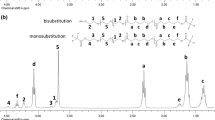Abstract
α,ω-Hydroxy telechelic poly(ε-caprolactone) (HOPCLOH) was synthesized by ring-opening polymerization (ROP) of ε-caprolactone (ε-CL).The ROP was catalyzed by ammonium decamolybdate in the presence of ether diols [HO-(CH2-CH2-O)m-H] (where m = 2, 3, 4, 5, 6, and 8) as initiators. The homopolymer HOPCLOH was obtained with the ether group (EG) [HO-PCL-(CH2-CH2-O)m-PCL-OH (HOPCLOH)] as part of the backbone of the polyester with a systematic increase in the segment of the EG. The number average molecular weight (Mn) for all samples were similar in the range of oligomers (Mn = 1240–1510 Da) to have a significant effect of the EG. The effect of the EG on the physical properties was evaluated by differential scanning calorimetry (DSC) where the crystallinity of HOPCLOH and the size of the EG showed a relationship inversely proportional. Poly(ester-urethanes) (PEUs) derived from HOPCLOH exhibited an elastomeric behavior, where long chains of EG induced poor mechanical properties. The use and selection of the ether diols as initiators in the ROP of CL to synthesize HOPCLOH was not trivial because these EG substituents affected the crystallinity, and the mechanical properties of their PEUs.









Similar content being viewed by others
References
Alger M (2017) Polymer science dictionary3rd edn. Dordrecht, Springer
Jakisch L, Garaleh M, Schäfer M, Mordvinkin A, Saalwächter K, Böhme F (2018). Macromol Chem Phys 219:1700327
Báez JE, Marcos-Fernández A, Galindo-Iranzo P (2011). Polym-Plast Technol Eng 50:839–850
Jeong K-H, Park D, Lee Y-C (2017). J Polym Res 24:112
Erdagi SI, Doganci E, Uyanik C, Yilmaz F (2016). React Funct Polym 99:49–58
Uyar Z, Öncel A (2018). J Polym Res 25:245
Lu Y, Cao J, Huang J, Xiong Z, Chen H, Xiong C, Chen D (2017). J Polym Res 24:200
Mandal M, Monkowius U, Chakraborty D (2016). J Polym Res 23:220
Báez JE, Marcos-Fernández A, Lebrón-Aguilar R, Martínez-Richa A (2006). Polymer 47:8420–8429
Sung S-J, Yun YH, Lee S, Park J-K, Kim D-H, Cho KY (2010). React Funct Polym 70:622–629
Guillaume SM (2013). Eur Polym J 49:768–779
Báez JE, Marcos-Fernández A, Martínez-Richa A, Galindo-Iranzo P (2017). Polym-Plast Technol Eng 56:889–898
Báez JE, Marcos-Fernández A, Galindo-Iranzo P (2011). J Polym Res 18:1137
Báez JE, Marcos-Fernández A, Navarro R, García C (2017). J Polym Res 24:199
Báez JE, Marcos-Fernández A (2011). Int J Polym Anal Charact 16:269–276
Takizawa K, Tang C, Hawker CJ (2008). J Am Chem Soc 130:1718–1726
Báez JE, Zhao R, Shea KJ (2017). Ind Eng Chem Res 56:10366–10383
Huang M-H, Li S, Coudane J, Vert M (2003). Macromol Chem Phys 204:1994–2001
Huang M-H, Li S, Vert M (2004). Polymer 45:8675–8681
Naguib HF, Abdel Aziz MS, Sherif SM, Saad GR (2011). J Polym Res 18:1217–1227
Báez JE, Marcos-Fernández A (2012). React Funct Polym 72:349–357
Báez JE, Ramírez D, Valentín JL, Marcos-Fernández A (2012). Macromolecules 45:6966–6980
Ping P, Wang W, Chen X, Jing X (2005). Biomacromolecules 6:587–592
Panwiriyarat W, Tanrattanakul V, Pilard J-F, Pasetto P, Khaokong C (2013). J Appl Polym Sci 130:453–462
Ma Z, Hong Y, Nelson DM, Pichamuthu JE, Leeson CE, Wagner WR (2011). Biomacromolecules 12:3265–3274
Lin C-Y, Hsu S-H (2015). J Biomed Mater Res B Appl Biomater 103B:878–887
Tatai L, Moore TG, Adhikari R, Malherbe F, Jayasekara R, Griffiths I, Gunatillake PA (2007). Biomaterials 28:5407–5417
Rattanapan S, Pasetto P, Pilard J-F, Tanrattanakul V (2016). J Polym Res 23:182
Wu C-L, Tsou C-Y, Tseng Y-C, Lee H-T, Suen M-C, Gu J-H, Tsuo C-H, Chiu S-H (2016). J Polym Res 23:263
Yuan J, Sang Z, Zhao J, Zhang Z, Zhang J, Cheng J (2017). J Polym Res 24:88
Li SQ, Zhao JB, Zhang ZY, Zhang JY, Yang WT (2015). Polymer 57:164–172
Li SQ, Sang ZH, Zhao JB, Zhang ZY, Cheng J, Zhang JY (2016). Eur Polym J 84:784–798
Báez JE, Martínez-Rosales M, Martínez-Richa A (2003). Polymer 44:6767–6772
Dey P, Hemmati-Sadeghi S, Haag R (2016). Polym Chem 7:375–383
Chausson M, Fluchère A-S, Landreau E, Aguni Y, Chevalier Y, Hamaide T, Adbul-Malak N, Bonnet I (2008). Int J Pharm 362:153–162
Báez JE, Ramírez-Hernández A, Marcos-Fernández A (2011). Int J Polym Anal Charact 16:377–389
Sigma-Aldrich is now Merck. Thermal transitions of homopolymers: glass transition & melting point. https://www.sigmaaldrich.com/technical-documents/articles/materials-science/polymer-science/thermal-transitions-of-homopolymers.html. Accessed 03 Dec 2018
Piao L, Dai Z, Deng M, Chen X, Jing X (2003). Polymer 44:2025–2031
Zamani S, Khoee S (2012). Polymer 53:5723–5736
Báez JE, Marcos-Fernández A, Navarro, R. Chem Pap accepted manuscript
Acknowledgments
José E. Báez thanks the “Consejo Nacional de Ciencia y Tecnología” (CONACYT) (Proyecto CONACYT Ciencia Básica 284893), Dirección de Apoyo a la Investigación y al Posgrado (DAIP) at University of Guanajuato (UG), and “Sistema Nacional de Investigadores (SNI)” in México for financial support of the work. José E. Báez also thanks to Ángel Marcos-Fernández for believing in these ideas and providing financial support for the reagents through the project MAT2017-87204-R from the Ministry of Economy and Competitiveness (MINECO) of Spain. José E. Báez also thanks to the UG for the recent opportunity to work as an Assistant Professor. Marvin was used for drawing, displaying, and characterizing chemical structures, substructures, and reactions (Marvin Sketch 6.1.3, 2013, ChemAxon; http://www.chemaxon.com); a free software program with an academic license was provided by ChemAxon. Finally, José E. Báez thanks to Gema Reina Mendieta for the acquisition of the NMR spectra.
Author information
Authors and Affiliations
Corresponding author
Rights and permissions
About this article
Cite this article
Báez, J.E., Marcos-Fernández, Á., Navarro, R. et al. A systematic study of macrodiols and poly(ester-urethanes) derived from α,ω-hydroxy telechelic poly(ε-caprolactone) (HOPCLOH) with different ether [CH2CH2O]m groups. Synthesis and characterization. J Polym Res 26, 32 (2019). https://doi.org/10.1007/s10965-018-1682-4
Received:
Accepted:
Published:
DOI: https://doi.org/10.1007/s10965-018-1682-4




